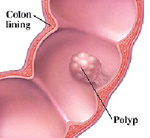Guide to Understanding Colorectal Polyps

Description
A colorectal polyp is a growth that sticks out of the lining of the colon or rectum.
Types of polyps
- Benign polyps: Polyps of the colon and rectum are usually benign, meaning they are not cancerous and they do not spread. There may be one or more polyps, and they become more common with age.
- Adenomatous polyps (or adenomas): Over time, certain types of polyps, called adenomatous polyps, may develop into colon cancer.
- Hyperplastic polyp: This type of polyp found in the colon does not develop into colon cancer.
- Polyps larger than 1cm: These types of polyps have a greater risk of becoming cancerous than polyps under 1cm in size.
Risk factors
- Age
- Family history of polyps or colon cancer
- A type of adenomatous polyp called villous adenoma
- Presence of “High-Grade Dysplasia” within an adenomatous polyp (i.e. the presence of more advanced pre-cancerous cells within a polyp)
Prevention
- Eat a diet low in fat (avoid red meat) and high in fruits, vegetables, and fiber
- Avoid smoking and excessive alcohol intake
- Maintain a normal body weight and exercise regularly
- Increase your Calcium and Vitamin D intake
- Consider regular Aspirin use if you are at a higher risk (e.g. history of previous, recurrent or advanced adenomas or colorectal cancer); regular Baby Aspirin (81mg daily) may reduce your risk of polyps (in addition to reducing your risk of a heart attack or stroke), but may increase your risk of Gastrointestinal bleeding
- Colonoscopy prevents colon cancer by removing polyps before they can become cancer. People over the age of 50 should consider having a colonoscopy (or other screening tests), which makes easier diagnosis and treatment possible. Those with family history of colon cancer or polyps may need to be screened at an earlier age.
Treatment
Since colorectal polyps can develop into cancer, they should be removed. In most cases, the polyps may be removed while a colonoscopy is being performed. For patients with adenomatous polyps, new polyps may appear in the future. Follow-up colonoscopy is usually recommended 1-to-5 years later, depending on: patient’s age and general health, number of polyps, and size and characteristics of the polyps.
Outlook (Prognosis)
The outlook for patients with colorectal polyps is excellent if the polyps are removed. Polyps that are left behind can develop into cancer over time.
Instructions following a Colonoscopy with Removal of Polyps
- If you had sedation, you should not drive and have somebody with you for the remainder of the day/night
- If you routinely take Aspirin/Coumadin on a daily basis, start again as directed by your physician.
- You may experience abdominal cramps or pain if air had to be inserted during the procedure. This will diminish once physical activity resumes. You may drink warm fluids to help release flatus (gas).
- Avoid vigorous exercise for 2-3 days. Walking and light housework is fine.
- A small amount of bleeding is normal. If you have severe bleeding, significant abdominal or shoulder tip pain, chills, and/or fever, please go to York Central Hospital or your nearest emergency department with this paper.
- It is important that you keep your follow-up appointment if one was suggested by your physician.

